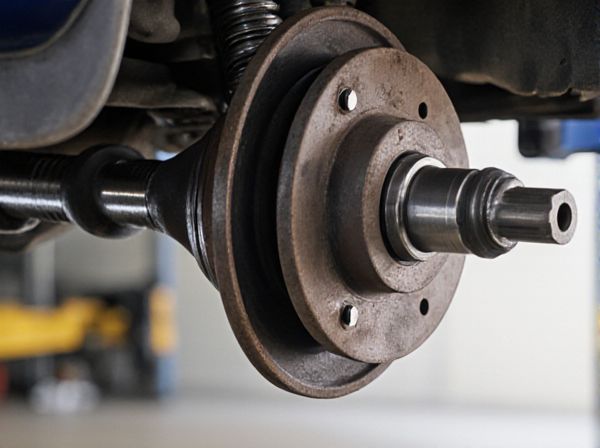
Photo illustration: Solid Shaft vs Hollow Shaft
A solid shaft offers greater strength and durability, making it ideal for heavy load applications, while a hollow shaft is lighter and reduces rotational inertia, improving efficiency in high-speed machinery. Your choice depends on the balance between weight, strength, and ease of maintenance required for the specific mechanical system. Hollow shafts also allow for better heat dissipation and can accommodate wiring or fluids inside, enhancing functionality in advanced engineering designs.
Table of Comparison
| Feature | Solid Driveshaft | Hollow Driveshaft |
|---|---|---|
| Weight | Heavier, reducing fuel efficiency | Lighter, improves vehicle performance |
| Strength | High strength, robust under heavy loads | Comparable strength with less material |
| Durability | Better resistance to impact and wear | Good durability with proper material choice |
| Cost | Lower manufacturing cost | Higher production cost due to design complexity |
| Performance | Less efficient due to weight | Better torque-to-weight ratio |
| Application | Used in heavy-duty vehicles and trucks | Preferred in sports and performance cars |
Introduction to Solid and Hollow Shafts
Solid shafts are typically made from a single piece of material, providing high strength and torsional rigidity, making them ideal for transmitting heavy loads in mechanical systems. Hollow shafts, designed with a cylindrical cavity, offer reduced weight and improved resistance to bending, which enhances efficiency in applications requiring a high strength-to-weight ratio. The choice between solid and hollow shafts depends on factors such as load requirements, weight constraints, and manufacturing costs.
Material Usage and Cost Efficiency
Hollow shafts typically use less material than solid shafts, resulting in reduced weight and lower raw material costs while maintaining comparable mechanical strength due to their optimized geometry. Solid shafts, although heavier and more material-intensive, provide simplicity in manufacturing and higher resistance to torsional stress in applications where weight is less critical. The cost efficiency of hollow shafts is prominent in industries like automotive and aerospace, where material savings directly translate to improved fuel economy and performance.
Strength and Load-Bearing Capacity
Hollow shafts offer comparable strength to solid shafts while significantly reducing weight, enhancing load-bearing capacity through optimized material distribution. Solid shafts provide higher torsional strength and resistance to shear stress due to their uniform cross-section, making them suitable for heavy-duty applications. Engineering design favors hollow shafts in scenarios requiring efficient strength-to-weight ratios and solid shafts where maximum rigidity and durability under intense loads are critical.
Weight Comparison and Applications
Hollow shafts offer a significant weight advantage over solid shafts due to reduced material volume while maintaining comparable strength and rigidity, making them ideal for applications requiring lower inertia and improved torque-to-weight ratios. Solid shafts provide higher torsional strength and durability, suitable for heavy-duty machinery where maximum load capacity and resistance to deformation are critical. Industries such as automotive and aerospace prefer hollow shafts for lightweight components, whereas construction and industrial equipment predominantly utilize solid shafts for robustness and longevity.
Torsional Rigidity and Performance
Solid shafts exhibit higher torsional rigidity compared to hollow shafts due to their greater polar moment of inertia, making them more resistant to twisting under applied torque. Hollow shafts, while offering reduced material weight, can achieve comparable performance by optimizing wall thickness, providing an advantageous strength-to-weight ratio crucial in automotive and aerospace applications. Engineers often select hollow shafts for dynamic systems requiring lower rotational inertia without significantly compromising torsional stiffness, enhancing overall mechanical efficiency and fatigue resistance.
Manufacturing Processes and Complexity
Solid shafts are typically manufactured through processes such as turning, forging, and grinding, offering simpler production steps and lower complexity due to their uniform cross-section. Hollow shafts require advanced manufacturing methods like tube drawing, welding, or machining from tubing, increasing complexity and production time due to the need to maintain dimensional accuracy and structural integrity. Cost and precision challenges are higher in hollow shaft manufacturing, driven by the intricate processes to achieve the balance of strength and weight reduction.
Durability and Maintenance Requirements
Hollow shafts offer enhanced durability due to their improved resistance to torsional stress and reduced weight, which decreases wear and tear in dynamic applications. Solid shafts typically require less frequent maintenance as they have a simpler design and fewer stress concentration points, making them more reliable in heavy-load conditions. Maintenance for hollow shafts often involves careful inspection for cracks or deformation, while solid shafts benefit from straightforward lubrication and alignment checks.
Common Industry Applications
Solid shafts are extensively used in heavy machinery and automotive drive systems where high torque and strength are critical, especially in engines and gearboxes. Hollow shafts find common applications in aerospace and robotics due to their lightweight properties and ability to reduce rotational inertia without compromising strength. Both types are essential in power transmission systems, with selection driven by factors like torque requirements, weight reduction, and vibration damping.
Advantages of Solid Shafts
Solid shafts offer superior strength and durability due to their uniform material distribution, making them ideal for high-torque applications. Their simpler manufacturing process leads to lower production costs and easier maintenance compared to hollow shafts. Solid shafts also provide enhanced resistance to torsional stress and bending, ensuring long-term reliability in heavy-duty machinery.
Advantages of Hollow Shafts
Hollow shafts offer significant advantages over solid shafts, including reduced weight, which enhances overall machinery efficiency and reduces rotational inertia. Their design improves torque-to-weight ratio, making them ideal for automotive and aerospace applications where strength and lightweight components are crucial. Hollow shafts also provide better resistance to torsional stress and allow for improved heat dissipation, increasing durability and operational lifespan.
 caratoz.com
caratoz.com